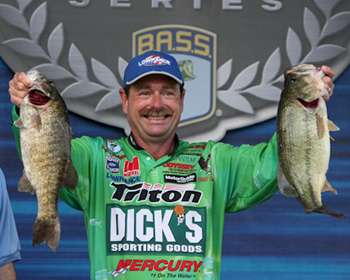
Elite Series pro Shaw Grigsby loves to catch big bass. From shallow grass lakes in his home state of Florida to deep, clear water on the West Coast, the tournament veteran has had his share of encounters with lunker bass.
Over the course of his career, Grigsby has developed an affinity for spinning tackle and refined the best technique for landing big fish on light line. His tips could spell the difference between triumph and heartbreak the next time a 6-pounder inhales your shaky head or drop shot on 6-pound-test line.
"One of my main tools is spinning equipment, and one of the things that people always worry about is landing a big fish on spinning tackle," says Grigsby. "It's designed for light line and finesse presentations, but every now and then you'll hook one of those big ol' pigs and have to land it."
While Grigsby acknowledges that the drag systems in today's high-end spinning reels are incredibly smooth and reliable, he favors a tactic called "back reeling" when fighting a big bass on light line. After setting the hook and determining the size of the bass, he'll disengage the anti-reverse feature on his spinning reel, allowing him to turn the handle in the opposite direction and feed line to the fish.
"When I'm back reeling, I can put as much pressure on the fish as I want while I'm reeling it in," he says. "If the fish decides to take off, I can just let the reel go backwards."
The main advantage of back reeling is the fact that Grigsby can maintain control over the amount of pressure he's putting on the bass at all times during the fight. "It's the perfect way to fight a fish rather than having to reach up and back off the drag. I think that adjusting the drag is insane because there's no way of knowing exactly how far you're backing the drag. All of the sudden it's too loose and then you have to tighten it," explains Grigsby.
While a drag exerts a constant amount of pressure, Grigsby's back reeling technique also allows him to fight a bass according to how it is hooked. If he notices that the fish is barely hooked, he can keep light pressure on the bass as it runs. If it's well hooked, he can apply more pressure and get the bass to the boat. In instances where he hooks an aggressive bass that makes a long run, Grigsby will use his finger to control the amount of line that the fish takes off the spool similar to how fly fishermen use their hands to control the drag.
"I'll actually put my finger on the spool so the bail will swing around and tick my finger as it spins backwards," he says. "Sometimes they'll run fast enough where I can't keep up with the fish just by back reeling."
(Provided by Z3 Media)




